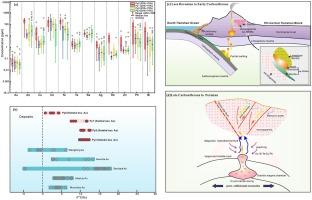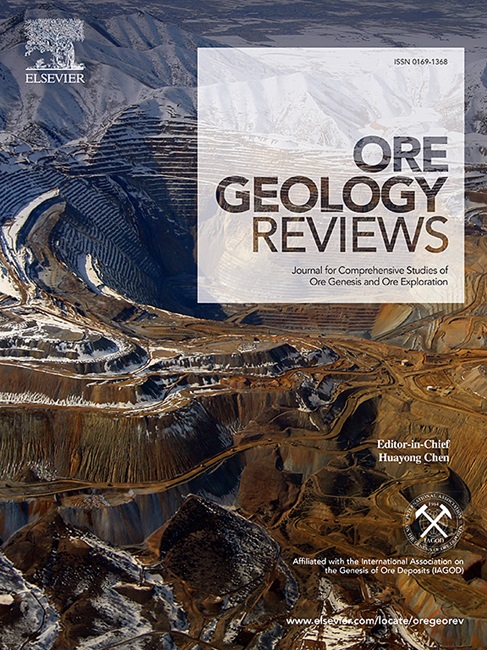中国天山西部凯特巴苏金矿床的成因:黄铁矿微量元素、硫同位素和石英 H-O 同位素的制约因素
IF 3.2
2区 地球科学
Q1 GEOLOGY
引用次数: 0
摘要
凯特巴苏金矿床位于中国西天山,是世界级天山金矿带最重要的发现之一。该矿床具有两种截然不同的矿化风格。早期的次生矽卡岩型铜金矿化出现在单斜长岩、闪长岩和志留纪石灰岩之间的接触带,由石榴石、透辉石、闪长岩、黄铜矿、黄铁矿和金组成。卡特巴阿苏金矿床中与金矿化有关的主要硫化物矿物是黄铁矿,已发现有四种类型:黄铁矿是凯特巴阿苏金矿床中与金矿化有关的主要硫化矿物,已确定有四种类型:Py0 来自早期的矽卡岩铜金矿化,Py1 至 Py3 来自后期的岩土金矿化。所有类型的黄铁矿都是均质的,含有极少量的晶格结合金。Py0 为八面体细粒黄铁矿,铜、金、钴和镍含量相对较高,并显示出岩浆硫同位素特征,δ34S 为 0.8 至 4.3 ‰。Py1在黄铁矿-石英矿脉中以八面体至近八面体的粗粒晶体出现,钴和镍的含量较高。Py2 出现在石英黄铁矿矿脉中,为中粗粒,与 Py1 相比,As、Cu、Zn 和 Bi 含量较高。Py3 出现在主要淀金阶段的多金属硫化物矿脉中,呈正方体,中细粒,与 Py1 和 Py2 相比,As、Ag、Cu、Zn、Se、Te 含量较高,Co 和 Ni 含量最低。所有黄铁矿类型的 Au-Te、Au-Bi、Au-Cu 和 Pb-Bi 之间的正相关性,以及 Py3 中可见金的存在,表明大多数金以微/纳米级包裹体和裂隙金的形式出现。Py1、Py2 和 Py3 的 δ34S 值(分别为 7.6 至 11.8 ‰、10.1 至 12.6 ‰ 和 9.8 至 12.4 ‰)归因于最初的岩浆源,并随后与来自壁岩的外部硫混合。锭金矿化中石英的 H 和 O 同位素组成(δDH2O = -84.1 至 -93.5 ‰;δ18OH2O = 1.8 至 6.6 ‰)表明,成矿流体主要来自岩浆,另外还有陨石水。综合来看,凯特巴阿苏金矿床的形成提出了一个分为两个阶段的成矿模式。早期的矽卡岩成矿阶段与早石炭纪的闪长岩成岩有关。相比之下,随后发生在晚石炭纪和二叠纪之间的鳞片金矿化则代表了一种岩浆-热液金系统的叠加,可能与深层岩浆侵入有关。本文章由计算机程序翻译,如有差异,请以英文原文为准。

Genesis of the Kateba’asu gold deposit, Western Tianshan, China: Constraints from pyrite trace element, sulfur isotope, and quartz H-O isotopes
The Kateba’asu gold deposit, situated in the Western Tianshan of China, is one of the most significant discoveries in the world-class Tianshan gold belt. The deposit features two distinct mineralization styles. The early, subordinate skarn-type copper–gold mineralization occurs in the contact zone between monzogranite, diorite, and Silurian limestone, composed of garnet, diopside, epidote, chalcopyrite, pyrite, and gold. The later, primary lode-gold mineralization is hosted in the altered monzogranite characterized by pervasive quartz-pyrite-sericite-chlorite-K-feldspar alteration and a well-develped veining systems.
Pyrite is the dominant sulfide mineral related to gold mineralization in the Kateba’asu gold deposit, with four types identified: Py0 from the early skarn copper–gold mineralization, and Py1 to Py3 from the later lode-gold mineralization. All types of pyrite are homogeneous and contain very low levels of lattice-bound gold. Py0 is euhedral and fine-grained, with relatively high Cu, Au, Co, and Ni contents, and displays a magmatic sulfur isotopic signature with δ34S ranging from 0.8 to 4.3 ‰. Py1 occurs as euhedral to subhedral, coarse-grained crystals within pyrite-quartz veins with higher concentrations of Co and Ni. Py2, which develops in the quartz-pyrite veins, is medium to coarse-grained and contains elevated levels of As, Cu, Zn, and Bi relative to Py1. Py3, found in polymetallic sulfide veins of the main lode-gold stage, is anhedral and medium to fine-grained with higher contents of As, Ag, Cu, Zn, Se, Te and lowest Co and Ni concentrations compared to Py1 and Py2. The positive correlations between Au-Te, Au-Bi, Au-Cu, and Pb-Bi across all pyrite types, along with the presence of visible gold in Py3, indicate that most gold occurs as micro-/nano-sized inclusions and as fissure gold. The δ34S values of Py1, Py2, and Py3 (7.6 to 11.8 ‰, 10.1 to 12.6 ‰, and 9.8 to 12.4 ‰, respectively) were attributed to an initial magmatic source and mixed with external sulfur subsequently from the wall rocks. The H and O isotopic compositions (δDH2O = −84.1 to −93.5 ‰; δ18OH2O = 1.8 to 6.6 ‰) of quartz from the lode-gold mineralization imply that ore-forming fluids were predominantly of magmatic origin, with a additional contribution from meteoric water. Taken together, a two-episode mineralization model was proposed for the formation of the Kateba’asu gold deposit. The early skarn mineralization stage is associated with the emplacement of diorite during the Early Carboniferous. In contrast, the subsequent lode-gold mineralization, occurring between the Late Carboniferous and Permian periods, represents a overprinted magmatic-hydrothermal gold system potentially linked to a deep-seated magmatic intrusion.
求助全文
通过发布文献求助,成功后即可免费获取论文全文。
去求助
来源期刊

Ore Geology Reviews
地学-地质学
CiteScore
6.50
自引率
27.30%
发文量
546
审稿时长
22.9 weeks
期刊介绍:
Ore Geology Reviews aims to familiarize all earth scientists with recent advances in a number of interconnected disciplines related to the study of, and search for, ore deposits. The reviews range from brief to longer contributions, but the journal preferentially publishes manuscripts that fill the niche between the commonly shorter journal articles and the comprehensive book coverages, and thus has a special appeal to many authors and readers.
 求助内容:
求助内容: 应助结果提醒方式:
应助结果提醒方式:


